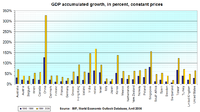
Photo from wikipedia
Numerous plant growth-promoting rhizobacteria (PGPR) have been inoculated into the soil with the aim of improving the supply of nutrients to crop plants and decreasing the requirement of chemical fertilizers.… Click to show full abstract
Numerous plant growth-promoting rhizobacteria (PGPR) have been inoculated into the soil with the aim of improving the supply of nutrients to crop plants and decreasing the requirement of chemical fertilizers. However, sometimes these microbes fail to competitively colonize the plant roots and rhizosphere. Hence, the plant growth promotion effect is not observed. Here, we describe a new screening strategy aiming at the selection of more competent PGPR. We evaluated bacterial phenotypes related to plant growth promotion, colonization, and persistence. Our results demonstrated that despite the fact that our Rhizobium sp. strains successfully solubilized phosphorus and produced siderophores, their abilities to spread over surfaces, resist hydrogen peroxide, and form biofilms varied. Additionally, a multicriteria decision analysis was used to analyze the data that originated from bacterial physiological characterizations. This analysis allowed us to innovatively evaluate each strain as a whole and compare the performances of the strains under hypothetical scenarios of bacterial-trait requirements. ABSTRACT The use of plant growth-promoting rhizobacteria (PGPR) is increasingly meaningful for the development of more environmentally friendly agricultural practices. However, often the PGPR strains selected in the laboratory fail to confer the expected beneficial effects when evaluated in plant experiments. Insufficient rhizosphere colonization is pointed out as one of the causes. With the aim of minimizing this inconsistency, we propose that besides studying plant growth promotion traits (PGP), the screening strategy should include evaluation of the microbial phenotypes required for colonization and persistence. As a model, we carried out this strategy in three Rhizobium sp. strains that showed phosphorus solubilization ability and production of siderophores. All strains displayed colonization phenotypes like surface spreading, resistance to hydrogen peroxide, and formed biofilms. Regarding their ability to persist, biofilm formation was observed to be influenced by pH and the phosphorus nutrient provided in the growth media. Differences in the competence of the strains to use several carbon substrates were also detected. As part of our framework, we compared the phenotypic characteristics of the strains in a quantitative manner. The data analysis was integrated using a multicriteria decision analysis (MCDA). All our results were scored, weighted, and grouped as relevant for PGP, colonization, or persistence. MCDA demonstrated that, when the phenotypes related to PGP and colonization are weighted over those for persistence, strain B02 performs better than the other two Rhizobium sp. strains. The use of our framework could assist the selection of more competent strains to be tested in greenhouse and field trials. IMPORTANCE Numerous plant growth-promoting rhizobacteria (PGPR) have been inoculated into the soil with the aim of improving the supply of nutrients to crop plants and decreasing the requirement of chemical fertilizers. However, sometimes these microbes fail to competitively colonize the plant roots and rhizosphere. Hence, the plant growth promotion effect is not observed. Here, we describe a new screening strategy aiming at the selection of more competent PGPR. We evaluated bacterial phenotypes related to plant growth promotion, colonization, and persistence. Our results demonstrated that despite the fact that our Rhizobium sp. strains successfully solubilized phosphorus and produced siderophores, their abilities to spread over surfaces, resist hydrogen peroxide, and form biofilms varied. Additionally, a multicriteria decision analysis was used to analyze the data that originated from bacterial physiological characterizations. This analysis allowed us to innovatively evaluate each strain as a whole and compare the performances of the strains under hypothetical scenarios of bacterial-trait requirements.
Journal Title: Applied and Environmental Microbiology
Year Published: 2020
Link to full text (if available)
Share on Social Media: Sign Up to like & get
recommendations!